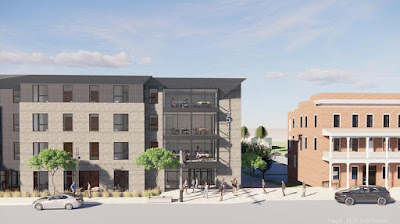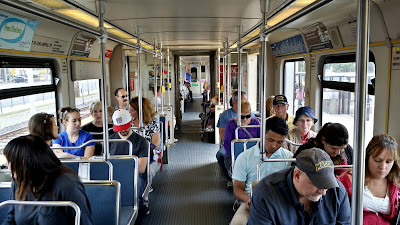If it was a bit hard to make out what Baltimore Public Markets CEO Paul Ruppert's was explaining to a group of land professionals in the assembly space of the spanking new Lexington Market it wasn't just because of his softspoken manner or the reverberation in the hard surfaced space but also because it is hard to wrap one's mind around the host of objectives Mr Ruppert was describing.
 |
| The new market: The Egg-laying Wool-Milk Pig? (Photo: Philipsen) |
The objectives were often contradictory: Wanting to give the existing merchants a chance to continue their business in the new much smaller building but also wanting a mix of merchants to more closely resemble the community that the market serves. Lexington Market is the go-to place in a vast food desert that spans large parts of the western wing of the "black butterfly". Also wanting to attract new shoppers and gaining back those that were lost in recent years. Ruppert pointed to the nearby University of Maryland and its large medical complex. Wanting goods to be fresh, healthy and local, catering to the daily needs of low income families while also attracting the discerning tastes of those who found the old market too stale and were looking for modern choices such as crispy fresh bread that doesn't come pre-sliced and plastic wrapped from a bread factory. Old staples like Faidley's fish market must remain, fresh meats as well, but much of the business of a modern day food hall comes from prepared foods. Ruppert says that the team managed to get the demographics right: 45% of all vendors will be black owned and nearly half of all will be woman owned. As if all of this wasn't already hard enough to do, the market is also supposed to remain the cherished cultural icon that the old market has been through more than a century, even though the surrounding area has experienced decline and modern retail is almost entirely absent in the old retail core. People have different expectations in the 21st century, the age of suburban 135, 000 square foot grocery stores, online orders, to the door deliveries and trendy food halls. Outwardly the BCT Architects designed market channels the old version from a 100 years ago, inside everything must be different.
 |
| A postcard of the historic market, maybe a 100 years ago |
Additional difficulties include geography: The entry level on Eutaw Street is 15’ below that of Paca Street, forcing the new ADA compliant market to be organized on two levels. Fresh foods on the lower level, Ruppert says, prepared food upstairs. Lexington Market is not only expected to flourish but also to rejuvenate the entire tired area of downtown, that many people avoid today for the many methadone clinics and abandoned or marginal shops along with a busy street live that many suburbanites find unsettling. In a gesture towards the new inviting outdoor plaza between the old and the new market, some vendors have sales windows for those walking by on the new plaza which is designed to accommodate events and lingering.
The tension between the many goals was illustrated when during a tour through the building Ruppert pointed to a spot right on top of the grand steps leading up to the top level. A great place for a brew-stand, he says, a local micro brewery has already applied, "but wouldn't it say 'gentrification' in this prominent space", he wondered aloud. To be clear, in most cases the vendors have been assigned and many shiny stainless steel pieces of equipment for cooling, frying, cooking and drinks stood proof, waiting to be installed in the various stalls. Kitchen and food preparation plans are taped to columns, next to the vendor numbers and names.
 |
| A grand stair: obstacle and opportunity (Photo: Philipsen) |
The project, designed for $40 million is behind schedule now, even though the shell has been complete for some months. First there was a funding gap stemming from risen cost, a problem that Mayor Scott deftly solved by putting $4.9 million rescue money on top of the initial price tag. Now delays in finishing the stalls are explained with supply chain issues and the general circumstances of a construction industry under stress.
Ruppert mentioned several times the impediments coming from the surrounding areas. The murder in front of the Hippodrome, the drug treatment clinics and the sad condition of much of the surrounding infrastructure. Does he get the support of the City to fix things before the Market will open in the fall? Answering this question Ruppert's voice is trailing off. I understood him saying something to the effect that this was an important question. Kristen Mitchell Forsyth who ran the Market Center Merchants Association and is now part of the Public Market team is extremely familiar with the area. At times she had cleaned up herself, broom and bags in hand. After Rupperts presentation she walked over to me to tell me that she has successfully initiated a bunch of smaller fixes and repairs on sidewalks, tree pits and curbs. She assures me that collaboration between the semi public Public Market Corporation and DPW is happening. Sidewalks at the NE corner of Eutaw and Saratoga have been replaced, and the brick sidewalks on the west side of the 300 block of Paca have been replaced, too. The brick tree wells on Howard Street, and some of the surrounding brick sidewalks, have been fixed. She also points to a newly painted facade across the street, part of a grant agreement. Bigger issues, though, remain unaddressed. What is needed, before the market opens, is a comprehensive sweep that includes BDC, Public Works, Housing and code inspectors. Some things have clearly festered way too long: For example, the giant burnt out historic Gomprecht complex on the same block as the market, last used as the Tunnel night club. It still stands as a burnt out ruin, unchanged since the morning after the fire, the cornice precariously dangling above the sidewalk in spite of years of complaints and discussions about structural safety, loitering, historic preservation, demolition and the shell remains a drag on the neighborhood.
 |
| The plaza between the old and the new market: An invitation to linger. (Photo: Philipsen) |
As CEO of the public markets, Ruppert is not only in charge of the Lexington Market, but has to address the same set of issues for Federal Hill's Cross Street Market, Fells Point's Broadway Market, Pennsylvania Avenue's Avenue Market, Northeast Market near Johns Hopkins Hospital, and Hollins Market in Southwest Baltimore as well. A tall order. All of them have recently been in play or are still subject to transformations with equally conflicting goals. As for Broadway and Cross Street, they clearly veered into the direction of gentrification and have become food halls of sort, not what Lexington Market and its smaller brethren at Hollins Street, Pennsylvania Avenue,and in the Northeast are supposed to become.
But how to cater to all these objectives and still have the market in general and the individual merchants in particular affordable, equitable and profitable all at once?
Will the Market Corporation be prepared to keep the merchants alive should they find it difficult to sell enough in this phase of Baltimore's history when many office workers didn't come back from their remote work, when students and hospital employees fear to tread in the area and tourists stay away from Baltimore, because it appears to be too dangerous? When much of the surroundings still signal neglect, no matter the small fixes on the public right of way?
 |
| The new Prospr on Fayette apartments and hotel complex south of the new market (Photo: Philipsen) |
Ruppert remained circumspect. Yes there are some wrap-around services provided to merchants, to help them get going, not only by the Public Market Corporation but also by the market developer Seawall and by BCL, Baltimore Community Lending. "This is Baltimore's largest small business incubator", Ruppert pointed out. But outright rent subsidies are not planned is my understanding.
Asking whether the market can survive before it has even opened and when everyone has the highest hopes for it may feel outright blasphemous and defeatist. "Typical Smalltimore spirit", some may object, just when this project is supposed to lift the entire Westside and Market Center area over the hump.
Yes, I would respond, the fact that the new market is beautiful and now within grasp after so many years of agonizing over its future is a great success. On the other hand so was Oriole Park, the construction of Baltimore's first new streetcar in the early 1990, the Convention Center expansion, the Hippodrome, the Everyman Theater, Centerpoint and the successful conversion of the old Hechts Department store. Positive signals are also a number of successful new projects in the area such as the new mixed use complex just to the south of the market and the Paca House social services west of the market.
 |
| The fire ruin at 360 N Eutaw in the same block as the market, untouched since 2017 (Photo: Philipsen) |
Somehow, though, all this has not yet translated into a truly vibrant revitalized destination neighborhood that would be in any way comparable to Over The Rhine in Cininnatti, the new Union Station and stadium area in downtown Denver or even the revitalized downtown of Lexington Kentucky.
For this to finally be achieved the Superblock and the the Weinberg demolition site across the street and next to the Steward's building need to be developed, the streetscape has to be upgraded and brought into shape. The goal must be several contiguous city blocks without shuttered shops and vacant buildings and decaying sidewalks. Public markets can thrive if they are located in thriving commercial areas.
Until that is achieved, the Public Market Corporation better angle for lucrative leases of the soon to be vacant old market buildings east and west of Paca Street so they have some cash-flow in addition to the already money making garage to prop up the market to whatever level is needed, so it can sustain to be the area magnet everybody wants it to be.
Klaus Philipsen, FAIA
Related articles on this blog:
The Future of Public Markets and the Case of the Lexington Market in Baltimore (2014)
View of Eutaw Street seen from the new event
space in the market (Photo: Philipsen)
Chaos around Baltimore's Public Markets (2017)

space in the market (Photo: Philipsen)
Old Baltimore on fire (2017)
Will the Lexingtonn Market finally be saved? (2018)
A brand-new retro Lexington Market is supposedly right around the corner (2019)















